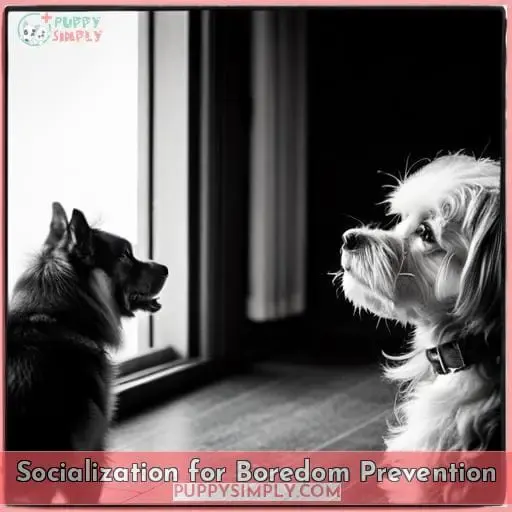This site is supported by our readers. We may earn a commission, at no cost to you, if you purchase through links.
 Ever sensed your canine companion’s restlessness? Understanding your dog’s behavior could reveal chronic boredom, impacting their well-being. Recognizing seven key signs of this distress is pivotal. Destructive tendencies, excessive attention-seeking, or even over-grooming might signal their boredom.
Ever sensed your canine companion’s restlessness? Understanding your dog’s behavior could reveal chronic boredom, impacting their well-being. Recognizing seven key signs of this distress is pivotal. Destructive tendencies, excessive attention-seeking, or even over-grooming might signal their boredom.
This prompts the need for diverse mental stimulation and tailored activities. By identifying these indicators and providing suitable engagement, you empower yourself to uplift your dog’s spirits and cultivate a fulfilling companionship.
Table Of Contents
- Key Takeaways
- Signs of Chronic Boredom in Dogs
- Recognizing Boredom in Dogs
- Physical Exercise for Mental Stimulation
- Socialization for Boredom Prevention
- Mental Stimulation With Food Puzzles
- Putting Your Dog to “Work
- Dealing With Excessive Barking
- Managing Your Dog’s Boredom
- Frequently Asked Questions (FAQs)
- Conclusion
Key Takeaways
- Provide your dog with daily exercise.
- Give your dog varied activities to keep them entertained.
- Socialize your dog with other dogs and people.
- Provide your dog with mental stimulation through interactive toys, puzzles, and games.
Signs of Chronic Boredom in Dogs
Do you notice your dog engaging in destructive behaviors such as:
- Chewing household items
- Excessive barking
- Digging in the yard?
Is your furry friend constantly seeking attention through:
- Whining
- Nudging your hand
- Jumping on you while walking?
Perhaps they’re always by your side and act like a shadow.
These signs could indicate that your dog is suffering from chronic boredom and is in need of mental and physical stimulation to alleviate their distress.
Destructive Behavior
If your dog shows signs of chronic boredom like chewing household items or digging, it might indicate underlying issues.
Destructive behaviors often link to unaddressed anxiety or lack of mental stimulation.
Addressing this by providing ample mental stimulation can alleviate destructive tendencies and associated anxieties, including excessive barking or separation anxiety.
Understanding these signs helps prevent chronic boredom, promoting a healthier and happier canine companion.
Constant Attention-Seeking
How does your dog consistently seek attention when feeling chronically bored?
Dogs display persistent attention-seeking behaviors like whining, nudging your hand, or sitting close, signaling their need for mental engagement. Training techniques and environmental enrichment can address this, providing cognitive challenges and behavioral modification.
Understanding such constant attention-seeking indicates chronic boredom, urging mental exercise and proactive measures to curb pacing behavior and promote a fulfilling, stimulating environment.
Proximity Clinginess
A clear indicator that your dog might be experiencing chronic boredom is their constant proximity to you, staying within a few feet at all times, displaying a behavior akin to being your shadow.
Understanding boundaries and behavioral modifications become crucial in addressing this. Dogs seek closeness as a coping mechanism for fear or chronic boredom, highlighting the impact of enrichment in their lives.
Identifying reasons behind this clinginess aids in implementing effective interventions.
Pacing Patterns
One clear indication that your dog may be suffering from chronic boredom is when you notice a repetitive pacing pattern, often indicating pent-up energy or a need for mental stimulation.
Exploring pacing motivations:
- Environmental enrichment lacking in the dog’s routine.
- Emotional responses linked to unmet behavioral triggers.
- Preventive measures involve incorporating puzzle toys and seeking veterinary advice for potential cognitive dysfunction syndrome.
Harassing Other Dogs
When your dog consistently bothers or provokes other dogs in the household, it might signal chronic boredom. Understanding canine communication and behavioral triggers is crucial. Employ training techniques and behavioral modification strategies to address this issue.
An interactive table below highlights key aspects of social dynamics and ethological approaches in managing dog boredom.
| Canine Communication | Behavioral Triggers |
|---|---|
| Body Language | Lack of Stimulation |
| Vocalizations | Restlessness |
| Scent Marking | Attention-Seeking |
| Play Behaviors | Frustration |
Over-Grooming
Your dog’s over-grooming, especially on the front legs, could be a sign of chronic boredom.
Try increasing mental stimulation and engagement with activities like:
- Puzzle toys
- Interactive games
- Training sessions
Recognizing Boredom in Dogs
If you’re concerned your dog is bored, there are a few things to look out for.
- Destructive behaviors, like chewing or scratching, are a common sign of boredom.
- Dogs of all breeds can experience boredom, and it’s important to provide them with plenty of mental and physical stimulation to prevent it.
- Evenings are especially important for dogs, as their day is just starting when you get home from work.
- Make sure to give your dog plenty of attention and affection, as this can also help to prevent boredom.
Negative Behaviors
Keep an eye on destructive behaviors like chewing, clawing, whining, or barking, as these could be signs of boredom.
- Chewing on household items
- Excessive barking
- Digging in the yard
- Counter-surfing or trash-diving
- Possible indication of separation anxiety
No Breed Exception
Boredom can affect all dog breeds, not just younger dogs or working breeds.
It’s important to recognize the signs of boredom and provide your dog with plenty of physical exercise, mental stimulation, and affection to prevent boredom from becoming a problem.
Evening Stimulation
Dogs may become more active when you return home from work, as their day is just starting. This could be a sign of boredom, so be sure to provide them with plenty of mental stimulation and physical activity throughout the day to prevent destructive behaviors and separation anxiety.
Behavioral Changes
Be aware that changes in your dog’s behavior could be a sign of boredom.
These include:
- Increased vocalization
- Decreased appetite
- Lethargy
- Changes in sleep habits
- Irritability
Importance of Affection
Recognizing boredom in your dog is important, and affection plays a crucial role in preventing it.
Affection provides:
- Physical touch
- Emotional support
- Mental stimulation
- Companionship
All of which are essential for a happy and healthy dog.
Physical Exercise for Mental Stimulation
Dogs need regular exercise to prevent boredom and obesity.
Explore new environments and engage in different activities and games to provide mental stimulation.
Running or biking requires dogs to focus on the activity, providing mental stimulation.
Daily Exercise
Daily exercise is crucial for preventing boredom and obesity in dogs.
Structured walks, short walks, long walks, and playtime are all great ways to burn energy, prevent boredom, and provide mental stimulation.
Varied Activities
In addition to daily exercise, provide your dog with varied activities throughout the day to prevent boredom.
This could include:
- Exploring new environments
- Playing different games
- Using interactive toys
- Providing mental challenges
Running or Biking
You should run or bike your dog regularly to provide mental stimulation and physical fitness.
- Increased endurance
- Mental stimulation
- Relieve stress
- Bonding with owner
Increased Focus
When you take your dog for a walk, make sure to:
- Vary the route and include interesting sights and smells to keep him engaged.
- This will help increase his focus, energy, and mental stimulation.
- You can also play games with him to teach him new skills and help him solve problems.
Attention and Engagement
Daily exercise is a great way to keep your dog physically and mentally stimulated, and prevent boredom.
Playing games, using interactive toys, and training treats are all great ways to provide mental stimulation and positive reinforcement.
Socialization for Boredom Prevention
Socialization is key to preventing boredom in dogs.
Dogs should easily interact with both humans and other dogs.
During puppyhood, dogs need lots of exposure to different environments, people, and pets.
Arrange play dates with dogs of similar temperaments and play styles.
If your dog is more active and social, consider a dog park or doggie day care.
Importance of Socialization
In addition to physical exercise, socialization is another important way to prevent boredom in dogs.
Early socialization is crucial for puppies as it helps them develop proper behavior and communication skills.
Socializing your dog with humans and other dogs has numerous benefits, including:
- Reducing anxiety
- Improving confidence
- Promoting positive interactions
Training classes or play dates can provide opportunities for socialization while ensuring a safe and controlled environment for your furry friend’s development.
Interaction With Humans
To prevent boredom, dogs should easily interact with both humans and other dogs.
Early socialization during puppyhood is crucial, and positive reinforcement-based obedience training can help teach your dog good manners and how to behave around people and other animals.
Dog parks, play dates, daycare, and boarding can also provide opportunities for socialization.
Puppyhood Socialization
How much socialization did your puppy experience during the first eight to ten weeks of life?
Early socialization is crucial for preventing boredom in dogs. Here are 3 things to remember:
- Expose your puppy to a variety of safe environments and people.
- Encourage positive experiences through structured play and positive reinforcement.
- Avoid overstimulating your puppy, as this can lead to fear and anxiety.
Play Dates
Arrange play dates with dogs of similar temperaments and play styles to prevent boredom.
Consider the age, frequency, scheduling, size, compatibility, location, availability, and supervision of potential playmates.
Alternatives
Dog parks and doggie day care are alternatives to play dates for more active and social dogs.
You can also provide mental stimulation with:
- Puzzle toys
- Kongs
- Training
- Obedience
- Agility
- Nosework
- Other enrichment activities.
Mental Stimulation With Food Puzzles
If you’re looking for ways to keep your dog entertained, consider using food puzzles.
These toys are designed to challenge your dog mentally and physically, and they can help to prevent boredom.
There are a variety of different food puzzles available, so you can find one that’s perfect for your dog’s age, size, and skill level.
Change Feeding Routine
Change your dog’s feeding routine to turn feeding into a mentally stimulating task.
Try hiding food, using interactive bowls, slow feeders, or puzzle toys.
Feed meals in different locations, hide food around the house, or feed meals at different times.
Puzzle Toys
Providing food through puzzle toys is a great way to stimulate your dog’s mind and prevent boredom.
Choose toys that are easy to use but challenging enough to keep your dog engaged.
Look for durable, dishwasher-safe toys that are made of non-toxic materials.
Interactive Bowls
In addition to puzzle toys, interactive bowls can also provide mental stimulation for your dog.
Learn how to use and clean interactive bowls, and where to buy them.
Mental and Physical Engagement
In addition to interactive bowls, have you tried using food puzzles to provide mental and physical engagement for your dog? Here are 4 ways food puzzles can benefit your dog:
- They provide mental stimulation.
- They encourage physical exercise.
- They can be tailored to your dog’s individual needs.
- They’re a great way to bond with your furry friend.
Tailored to Dog’s Needs
Tailoring activities to your dog’s needs can help prevent boredom, so make sure to include mental stimulation with food puzzles.
There are many different types of puzzles available, so you can find one that’s challenging and interactive for your furry friend.
Food puzzles are a great way to provide mental stimulation and enrichment for your dog, and they can also be a lot of fun!
Putting Your Dog to “Work
If your dog is suffering from chronic boredom, consider giving them a job to do.
High-energy dogs, in particular, crave tasks or games.
Nosework, teaching new behaviors, and exercise as work are all great ways to prevent excess energy and keep your dog entertained.
High-Energy Dogs
If you have a high-energy dog, it’s important to give them plenty of opportunities to work their brains and bodies.
High-energy dogs require regular exercise and mental stimulation to prevent boredom and destructive behavior.
Engaging in activities like obedience training, agility courses, or nosework can provide the mental challenge they need.
Play dates with other dogs can also help with socialization and burn off excess energy.
Meeting your dog’s energy needs won’t only keep them physically fit but also mentally satisfied.
Nosework
First, try incorporating nosework into your dog’s routine to provide mental stimulation and alleviate chronic boredom.
Nosework is a fun and engaging activity that taps into your dog’s natural scent identification abilities.
- Hide treats around the house for your beginner-level pup to find.
- Gradually increase the difficulty by hiding treats in more challenging spots.
- Consider enrolling in advanced nosework classes for professional guidance.
- Remember, it’s not just about finding treats; it’s about providing your dog with a purposeful task that satisfies their instincts while keeping them mentally stimulated.
By introducing nosework into your dog’s routine, you can turn their natural sniffing abilities into an exciting game that helps combat boredom effectively.
Teaching New Behaviors
Teaching your dog new behaviors can help provide mental stimulation and prevent boredom. There are many fun and rewarding ways to teach your dog new tricks, and it’s a great way to bond with your furry friend.
| Training Method | Benefits | Examples |
|---|---|---|
| Positive Reinforcement | Most effective | Treats, praise, toys |
| Shaping | Teaches complex behaviors | Gradually rewarding closer approximations to the desired behavior |
| Clicker Training | Marks desired behaviors | A clicker or marker word is used to signal that the dog has performed the desired behavior |
| Desensitization & Counterconditioning | Helps dogs overcome fears | Gradually exposing the dog to the feared stimulus in a controlled environment while providing positive reinforcement |
| Positive Reinforcement vs. Negative Reinforcement | ||
| Positive reinforcement encourages behaviors by adding something desirable | ||
| Negative reinforcement discourages behaviors by removing something undesirable | ||
| Positive Reinforcement vs. Punishment | ||
| Positive reinforcement encourages behaviors | ||
| Punishment discourages behaviors |
Exercise as Work
Give your high-energy dog a job by making him your running or agility partner.
Playing with toys and going for walks are great ways to provide mental stimulation, but finding a job or joining a club will help your dog feel like a working dog and give him the socialization he needs.
Preventing Excess Energy
If your dog has a lot of energy, give them a job to do to prevent boredom.
This could include:
- Regular exercise
- Varied activities
- New environments
- Interactive toys
- Problem-solving games
- Nosework games
- Scent identification
- Agility training
- Obedience classes
Dealing With Excessive Barking
Excessive barking is a common sign of boredom in dogs. It can be caused by:
- Loneliness
- Frustration
- Territorial behavior
If your dog is barking excessively, there are a few things you can do to help, such as:
- Providing them with more exercise
- Attention
- Mental stimulation
Excessive Barking as an Indicator
Excessive barking is one of the most common signs of boredom in dogs.
It could be a sign of frustration, loneliness, or anxiety.
If your dog is barking excessively, try to find ways to stimulate them mentally and physically.
Boredom, Loneliness, and Frustration
Your dog’s excessive barking could be a sign of boredom, loneliness, or frustration.
- Provide more mental and physical stimulation.
- Encourage your dog to play with other dogs or people.
- Make sure your dog has a comfortable place to sleep and rest.
- Take your dog to the vet to rule out any medical conditions.
Territorial Behavior
Excessive barking can be a sign of territorial behavior.
Dogs may bark to:
- Guard their territory
- Mark their territory
- Show aggression towards other dogs or people
If your dog is barking excessively, it’s important to determine the cause and address it accordingly.
Separation Anxiety
In addition to boredom, loneliness, and frustration, excessive barking can also be a sign of separation anxiety.
- They bark excessively when you leave
- They pace or whine when you’re gone
- They destroy things when you’re gone
- They become clingy when you’re home
Managing Your Dog’s Boredom
If you notice your dog exhibiting signs of boredom, like excessive barking or destructive behaviors, it’s important to take steps to manage their boredom.
This can be done by:
- Observing your dog’s behavioral patterns
- Tailoring activities to their breed
- Incorporating mental stimulation
- Seeking professional guidance
Monitoring changes in your dog’s behavior over time will help you determine the best course of action for managing their boredom.
Observing Behavioral Patterns
There are a number of ways to observe your dog’s behavioral patterns for signs of boredom.
- Whining
- Barking
- Licking
- Scratching
- Pacing
You can also look for changes in your dog’s eating and sleeping habits.
| Behavior | Possible Cause |
|---|---|
| Whining | Boredom, anxiety, or pain |
| Barking | Boredom, excitement, or aggression |
| Licking | Boredom, anxiety, or stress |
| Scratching | Boredom, allergies, or fleas |
| Pacing | Boredom, anxiety, or stress |
Tailoring Activities to Breed
After observing your dog’s behavioral patterns, you can tailor activities to their breed to help prevent boredom.
- Energy levels and exercise needs
- Physical and mental stimulation
- Interactive and puzzle toys
Puppies need plenty of socialization, while herding and hunting breeds crave tasks or games.
Incorporating Mental Stimulation
In addition to tailoring activities to your dog’s breed, incorporating mental stimulation can help manage boredom.
This can include:
- Puzzle toys
- Food puzzles
- Interactive games
- Treat dispensing toys
- Nosework games
- Scent games
- Training games
- Obedience games
- Agility games
- Obstacle courses
Seeking Professional Guidance
If you’re unsure about how to effectively manage your dog’s chronic boredom, it may be beneficial to seek professional guidance from a certified trainer or behaviorist.
Here are the benefits of professional guidance:
- Expertise: A qualified trainer can assess your dog’s specific needs and design a tailored plan.
- Behavior Modification Techniques: Trainers use positive reinforcement methods to address underlying issues causing boredom.
- Training Types: They offer various types of training, such as obedience training or specialized classes like agility or nosework.
- Cost Considerations: While there’s an investment involved in hiring a trainer, their expertise can save you time and frustration in the long run.
By seeking professional help, you’ll have access to valuable knowledge and support that will assist you in managing your dog’s chronic boredom effectively while fostering a deeper bond with them through engaging activities and mental stimulation techniques.
Monitoring Changes in Behavior
Once you have consulted with a professional, monitoring changes in your dog’s behavior will help you manage their boredom.
Observe your dog’s:
- Mood
- Behavior
- Personality
- Energy levels
for any changes that could indicate boredom.
Frequently Asked Questions (FAQs)
What are the signs of chronic boredom in dogs?
Signs of chronic boredom in dogs include:
- Destructive behaviors
- Attention-seeking behaviors
- Constant proximity to you
- Pacing behavior
- Harassing other dogs
- Over-grooming
How can I tell if my dog is bored?
Your dog may be bored if they’re:
- Destructive
- Whining
- Following you around constantly
Try giving them more:
- Exercise
- Mental stimulation
- Socialization
What are some ways to relieve boredom in dogs?
Boredom in dogs can be relieved with:
- Plenty of exercise
- Mental stimulation
- Socialization
- Interactive toys
What are the dangers of boredom in dogs?
Boredom in dogs can lead to:
- Destructive behaviors
- Separation anxiety
- Other health problems
Make sure your dog gets plenty of:
- Exercise
- Mental stimulation
- Socialization
What should I do if my dog is bored?
If your dog is bored, there are a number of things you can do to help them, including:
- Providing them with more exercise.
- Mental stimulation.
- Socialization.
Conclusion
When your furry friend is acting out, it could be a sign of boredom.
By understanding the signs and providing your dog with the right amount of mental stimulation, you can help them live a happy, healthy life.














